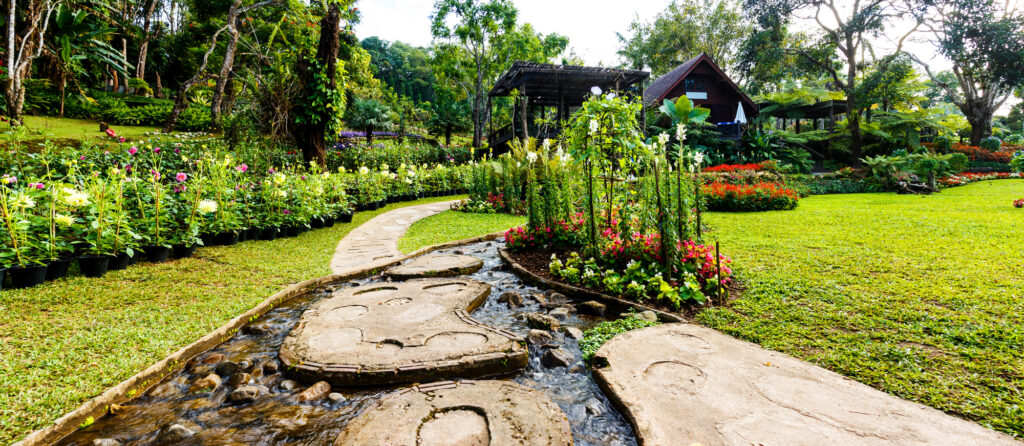Living in Metro Atlanta we are fortunate to have some large lakes nearby and this is great if you own a boat. Envision a retreat just outside your own back door, a place where you can escape and be near water.
Adding a water feature to the exterior of your home is a great way to augment the beauty of your landscape and a great way to reduce stress. No yard is too small, in fact, even if you live in a townhouse or condo, you can still enjoy the benefits of a water features in Atlanta.
Contact Us


Waterfalls regardless of their size, add variety to the landscape. What’s more a waterfall may provide a solution for areas otherwise difficult to landscape, such as, steep slopes, rocky terrain, or deep shade.
Waterfall Installation
Before planning a waterfall, look for inspiration. Take time to observe some of nature’s creations. Notice the water basin or area at the top of the falls and how the water spills over and around the rocks. Also, look at the land around the top, sides and bottom of a fall. Waterfalls contribute motion and sound to a landscape.
The design of a watercourse determines the emotions it elicits–exciting or calming, energizing or restful. Waterfalls regardless of their size, add variety to the landscape. What’s more a waterfall may provide a solution for areas otherwise difficult to landscape, such as, steep slopes, rocky terrain, or deep shade. A forceful waterfall helps minimize traffic noise.
An informal or naturalistic design typically includes a single spillway surrounded by an outcropping of rocks or a rock garden. Or you might opt for a multiple cataract waterfall, where more than one stream flows over the spillway. The plumbing for this design utilizes a manifold behind the falls that divides the water pipeline from the pump into two or more lines. Each line has its own valve to regulate how much water flows over each part of the waterfall and through the rock face as it discharges water between rocks at the top of the waterfall.
.
Fountain Installation
Several types of urns can be converted into brimming water pots, from large upright focal points to pitchers casually lying on their sides, spilling into a pond. An urn can be large enough to be a presence in your yard and this elegant water feature is a visual treat for anyone who desires a subtle addition of moving water. They can look especially inviting near your front or back door surrounded by colorful foliage and unobstructed blue sky reflecting the water.
Fountains will most definitely attract birds and butterflies. The magical effect is created by burying a plastic container under the ground that catches the falling water and recirculates it back into the pot. With the workings of the fountain hidden under a layer of rock and wire mesh, admirers are free to enjoy the never-ending stream of water.
Pond Installation
When planning a pond you need to consider, placement, size, and depth. Most ponds will be enjoyed if they are installed close to the home. Select an area where you can see the pond year-round. If possible, pick a location that can be viewed not only from your yard but from the inside of your house too, such as near the kitchen or family room window. Many sources instruct you, in no uncertain terms, not to build a pond near trees, as falling leaves, needles and cones can quickly contaminate the water. This is good advice, but do not treat is as the final word. Many ponds exist quite successfully among trees.
If you prefer to locate your pond near one or more trees, or if you have no choice, keep these things in mind. Leaves can be skimmed. Consider how much sunlight your proposed site will receive, and then choose plants and fish most likely to thrive in that environment.
The best way to determine the size of your pond is to use a rope or water hose and lay out the shape on the ground. The biggest mistake most people make is building too small of a pond. A larger pond is actually more stable and easier to maintain. Keep in mind that a finished pond will be about 30% smaller than you visualize it.
Ponds that are too shallow (less than 18 inches deep) are very hard to stabilize. To grow water lilies in Atlanta you will need a depth of at least 2 feet. If you desire a koi pond then a larger and deeper pond is necessary. To create the best environment for a variety of plants and fish, design your pond with varying depths.
If you are interested in learning more about water features, contact us today.

When planning a pond you need to consider, placement, size, and depth. Most ponds will be enjoyed if they are installed close to the home. Select an area where you can see the pond year-round.
